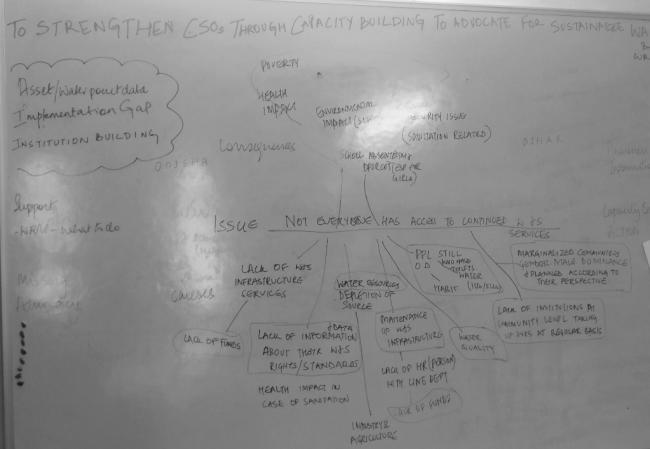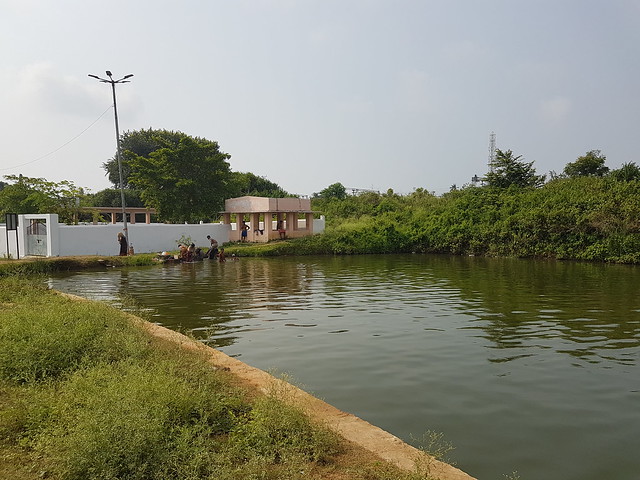Problem tree analysis is a good tool to plan, assess and adapt WASH programmes. Lessons from Watershed India.
In the course of every programme there comes a time to revisit its objectives. Since its launch in 2016, the consortium and landscape partners have implemented a number of activities under the Watershed India programme. The overall goal of the programme is to build the capacity of civil society organisations (CSOs) to advocate for improvements in governance and management of water, sanitation, and hygiene (WASH) services along with water resources (on which such services depend), specifically in one district each in Bihar and Odisha. The interventions have included an extensive baseline survey and various workshops to build capacities on topics ranging from government programmes and finance for WASH, water resource management, gender and more.
Nearly 2 years since its implementation, a need was felt to retrace the footsteps of the Watershed India programme. Towards this, a ‘Stock Taking and Forward Planning’ workshop was organised in November 2018 with the consortium and landscape partners. As suggested by the name, the purpose of the workshop was to revisit the activities undertaken, to take stock as well as assess them in terms of the overall goal of the programme, and plan the future course of action. The assessment of ‘how far have we come’ and ‘are we doing the right things’ was to provide the team space to take a step back and confirm whether the right trajectories were being followed. The purpose of these exercises was also to draw out the interlinkages between the various programme activities and analyse how each had contributed to the overall goal.
Problem tree analysis
The key feature of the workshop was the use of the ‘problem tree analysis’ tool. This is a participatory tool that pictorially represents a problem, its causes and its consequences. It helps the team get a quick glance of how a range of complex issues contributes toward a problem, the inter linkages between the issues, and how the problem branches out into a set of consequences. A problem tree analysis is a way for the partners to look afresh at how to achieve the programme goal: local CSOs that have the capacity to advocate for improved WASH services. The exercise also helps to map out the ways in which the programme is trying to resolve the problem at present and must focus on in the future.

Watershed India problem tree analysis. Photo: Isha Parihar
The problem in the case of the two partner districts in Bihar and Odisha was the lack of universal access to water and sanitation services. The causes of this problem, as shared by the landscape partners from the two districts, were:
- lack of adequate infrastructure to deliver water and sanitation services as a consequence of insufficient funds and/or low/no maintenance
- lack of maintenance of water and sanitation facilities as a consequence of inadequate human resources at the line department or insufficient funds
- lack of knowledge on minimum standards for water and sanitation services
- depletion of water resources
- the practice of open defecation due to shortage of water or habit
- lack of strong grassroots organisations (Panchayati Raj Institutions (PRIs), CSOs, village committees) in terms of numbers or capacities to adequately highlight and address water and sanitation issues
- water and sanitation needs of marginalised communities are overlooked
The consequences of the problem ranged from environmental degradation to poor health of the residents, poverty, school absenteeism as well as the risk of sexual harassment of women. The next step was to deliberate on the ways in which the Watershed programme was addressing the causes of the problem and highlight what was needed to be done.
Capacity building on budget tracking and IWRM
The discussion on the ways in which the Watershed India programme was addressing the identified problem was reassuring. It was mentioned that both the causes (1 & 2) of inadequacy of infrastructure as a consequence of insufficient funds and lack of maintenance of facilities as a consequence of inadequate human resources or insufficient funds were being addressed by the consortium’s work on building capacities of CSOs on budget tracking. The process of budget tracking would provide the CSOs insights into the total amount of funds available with the Gram Panchayat. The Life Cycle Cost Approach (LCCA) of budget tracking, in addition, would provide insights in to the manner of usage of funds. The LCCA analysis would inform whether poor maintenance of infrastructure was a result of inadequate budgeting for direct support (to pay for salaries) of the service or inadequate budgeting for long term and short term repairs: capital maintenance expenditure (CapManEx) and operations and minor maintenance expenditure (OpEx).
Further, the situation of depleting water resources (cause 4), the discussion highlighted, was being directly addressed by the consortium’s work on building capacities of CSOs in integrated water resource management (IWRM), including water resource mapping. The mapping process would provide an inventory of existing water resources, insights in to their future condition (if practices remain the same), and lead to the necessary mitigation measures. The consortium’s work in this regard would also partly address the practice of open defecation (cause 5) by building on the WASH-IWRM linkage.
Thus, it was felt that the consortium’s two focus activities – building capacities on tracking and use of budgets and IWRM – were fully addressing some of the causes and partially the others. This led to the identification of the following activities for 2019:
- capacity development of grassroots institutions such as Village Water Security Committees (VWSCs) on WASH and IWRM
- capacity building of the community, with due inclusion of women and marginalised groups, on knowledge, skills, linkages with government line departments and budgets. Identification and development of leaders from the community.
- institution building for maintenance and monitoring of infrastructure through VWSCs, Gram Panchayat Development Plans (GPDPs) etc
- capacity building of CSOs to understand existing government programmes and funds for WASH
- capacity building of CSOs on information related standards, services and possible budgets.
The discussion brought to light that the root cause of the problem was lack of capacities of grassroots institutions. This pointed towards the need to strengthen the institutions in terms of their capacity to plan, implement the plans, and coordinate with the line departments to ensure access to sustainable WASH services. The discussion also highlighted the need to make the CSOs aware of government schemes and minimum standards for villages so that they can demand the services accordingly. The Watershed programme was thus felt to be a step taken in the right direction, to build and strengthen capacities of CSOs to improve access to WASH services for everyone.
This blog was written by Shiny, shiny@ircwash.org and Ruchika, ruchika@ircwash.org
For more information please contact Ruchika

